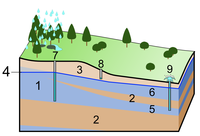
Photo from wikipedia
Drops sliding down an adaptive surface lead to changes of the dynamic contact angles. Two adaptation processes play a role: (i) the adaptation of the surface upon bringing it into… Click to show full abstract
Drops sliding down an adaptive surface lead to changes of the dynamic contact angles. Two adaptation processes play a role: (i) the adaptation of the surface upon bringing it into contact to the drop (wetting) and (ii) the adaptation of the surface after the drop passed (dewetting). In order to study both processes, we investigated samples made from random styrene (PS)/acrylic acid (PAA) copolymers, which are exposed to water. Sum-frequency generation spectroscopy (SFG) and tilted-plate measurements indicate that during wetting, the PS segments displace from the interface, while PAA segments are enriched. This structural adaptation of the PS/PAA random copolymer to water remains after dewetting. Annealing the adapted polymer induces reorientation of the PS segments to the surface. This article is protected by copyright. All rights reserved.
Journal Title: Macromolecular rapid communications
Year Published: 2022
Link to full text (if available)
Share on Social Media: Sign Up to like & get
recommendations!